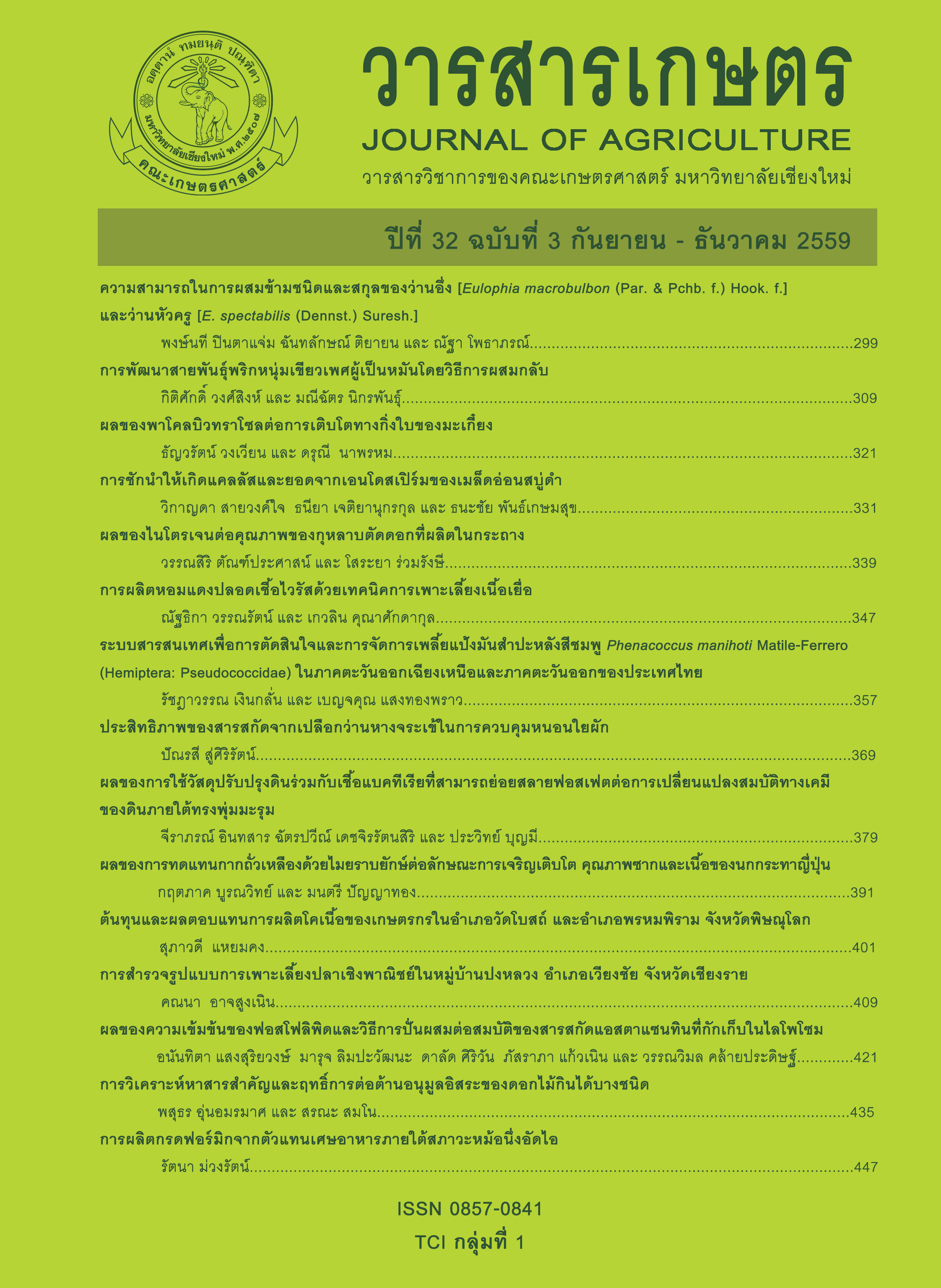Production of Formic Acid from Representative Food Waste Under Autoclave Conditions
Main Article Content
Abstract
Representative food waste containing cooked rice, pork sirloin and vegetable oil which weight percentage of composition was approximately 33.33% (w/w) each. The representative food waste heated under autoclave conditions (121 ºC, 101.3 kPa) could produce formic acid while acetic acid was not detected. Using either H2O2 or NaOH alone could accelerate the breakdown of reprehensive food waste into formic acid. Increasing concentration of H2O2 increased amount of formic acid. When the concentration of H2O2 was higher than 0.09 % (w/w), the yield of formic acid decreased. The higher amount of H2O2 decomposed compounds such as formic acid into CO2 or CO leading to the reduction of formic acid content. The degradation of reprehensive food waste using NaOH was higher than that using H2O2. Higher amount of NaOH increased the amount of formic acid. The concentration of NaOH was larger than 0.5 M resulting in a decrease in formic acid quantity. The NaOH could react with amino acids and lipids to form amino acid salts and soap products via neutralization reaction and saponification reaction, respectively, leading to a reduction in NaOH content. A longer time for the degradation of representative food waste under autoclave conditions increased the yield of formic acid. The degradation of reprehensive food waste using NaOH alone was higher than that using H2O2 alone or using both H2O2 and NaOH, respectively. The main mechanism of chemical reactions for formic acid production using both NaOH and H2O2 under autoclave conditions (121 ºC, 101.3 kPa) will be researched further.
Article Details
References
American Society for Testing and Materials (ASTM). 2012. Standard test method for ash in the analysis sample of coal and coke from coal; ASTM D3174-12; ASTM International: West Conshohocken, PA, USA.
American Society for Testing and Materials (ASTM). 2008. Standard test methods for instrumental determination of carbon, hydrogen, and nitrogen in laboratory samples of coal; ASTM D5373-08; ASTM International: West Conshohocken, PA, USA.
American Society for Testing and Materials (ASTM). 2009. Standard test method for determination of major and minor elements in coal, coke, and solid residues from combustion of coal and coke by inductively coupled plasma-atomic emission spectrometry; ASTM D6349-09; ASTM International: West Conshohocken, PA, USA.
American Society for Testing and Materials (ASTM). 2010. Standard test method for analysis of natural gas by gas chromatography; ASTM D1945-03; ASTM International, 100 Bar Harbor Drive, West Conshohocken, PA 19428 USA.
American Society for Testing and Materials (ASTM). 2012. Standard method for the examination of water and wastewater. The American Public Health Association (APHA), the American Water Works Association (AWWA), and the Water Environment Federation (WEF). 22nd ed.
American Society for Testing and Materials (ASTM). 2007. Standard test methods for moisture, ash, and organic matter of peat and other organic soils; ASTM D2974-07a; ASTM International: West Conshohocken, PA, USA.
Arni, S.A., M. Zilli and A. Converti. 2007. Solubilization of lignin components of food concern from sugarcane bagasse by alkaline hydrolysis. Cienciay Tecnologia Alimentaria 5(4): 271-277.
Chang, J.I. and T.E. Hsu. 2008. Effects of compositions on food waste composting. Bioresource Technology 99(17): 8068-8074.
Corma, A., S. Iborra and A. Velty. 2007. Chemical routes for the transformation of biomass into chemicals. Chemical Reviews 107: 2411-2502.
Digman, B. and D.S. Kim. 2008. Review: Aternative energy from food processing wastes. Environmental Progress 27(4): 524-537.
Elbeshbishy, E., H. Hafez and G. Nakhla. 2011. Ultrasonication for biohydrogen production from food waste. International Journal of Hydrogen Energy 36: 2896-2903.
Elliott, D.C. 2008. Review: Catalytic hydrothermal gasification of biomass. Biofuels, Bioproducts and Biorefining 2: 254-265.
Hao, X.H., L.J. Guo, X. Mao, X.M. Zhang and X.J. Chen. 2003. Hydrogen production from glucose used as a model compound of biomass gasified in supercritical water. International Journal of Hydrogen Energy 28(1): 55-64.
Huber, G., S. Iborra and A. Corma. 2006. Synthesis of transportation fuels from bio-mass: chemistry, catalysts, and engineering. Chemical Reviews 106: 4044-4098.
Jin, F., Y. Watanabe, A. Kishita, H. Enomoto and H. Kishida. 2008. Production of acetic acid by hydrothermal two-step process of vegetable wastes for use as a road deicer. Journal of Physics: Conference Series 121(8).
Kojima, Y., T. Fukuta, T. Yamada, M.S. Onyango, E.C. Bernardo, H. Matsuda and K. Yagishita. 2005 Catalytic wet oxidation of o-chlorophenol at mild temperatures under alkaline conditions. Water Research 39(1): 29-36.
Kruse, A. 2008. Supercritical water gasification. Biofuels, Bioproducts and Biorefining 2(5): 415-437.
Lu, M., X. Zeng, J.L. Cao, Z.B. Huo and F.M. Jin. 2011. Production of formic and acetic acids from phenol by hydrothermal oxidation. Research on Chemical Intermediates 37: 201-209.
Muangrat, R., J.A. Onwudili and P.T. Williams. 2010. Influence of alkali catalysts on the production of hydrogen-rich gas from the hydrothermal gasification of food processing waste. Applied Catalysis B: Environmental 100(3-4): 440-449.
Muangrat, R., J.A. Onwudili and P.T. Williams. 2012. Reactions of different food classes during subcritical water gasification for hydrogen gas production. International Journal of Hydrogen Energy 37(3): 2248-2259.
Onwudili, J.A. and P.T. Williams. 2010. Hydrothermal reactions of sodium formate and sodium acetate as model intermediate products of the sodium hydroxide-promoted hydrothermal gasification of biomass. Green Chemistry 12: 2214-2224.
Quitain, A.T., M. Faisal, K. Kang, H. Daimon and K. Fujie. 2002. Low-molecular-weight carboxylic acids produced from hydrothermal treatment of organic wastes. Journal of Hazardous Materials 93(2): 209-220.
Tedsree, K., T. Li, S. Jones, C.W.A. Chan, K.M.K. Yu, P.A.J. Bagot, E.A. Marquis, G.D.W. Smith and S.C.E. Tsang. 2011. Hydrogen production from formic acid decomposition at room temperature using a Ag-Pd core-shell nanocatalyst. Nature Nanotechnology 6: 302-307.
U.S. Environmental Protection Agency (USEPA). 2001. Total, Fixed and Volatile Solids in Water, Solids and Biosolids; EPA-821-R-01-015; Water Resource Center: Washington, DC, USA.
Yun, J., F. Jin, A. Kishita, K. Tohji and H. Enomoto. 2010. Formic acid production from carbohydrates biomass by hydrothermal reaction. Journal of Physics: Conference Series 215.


